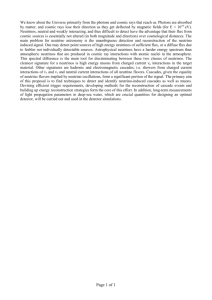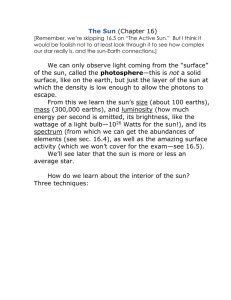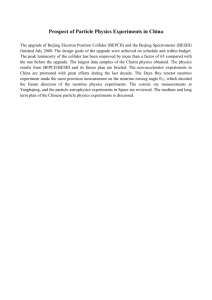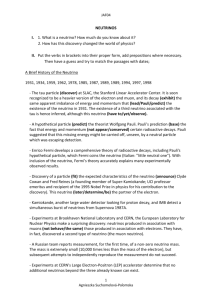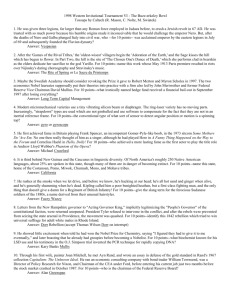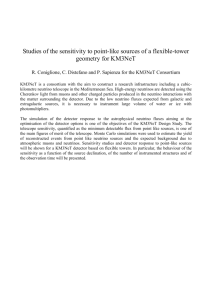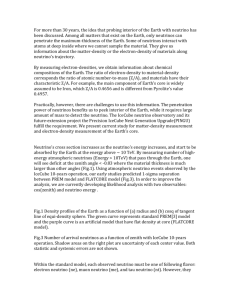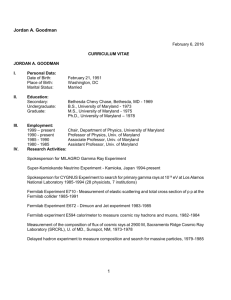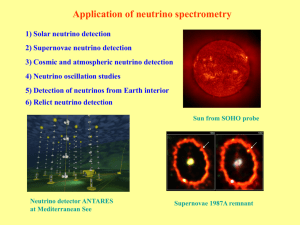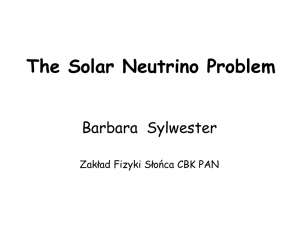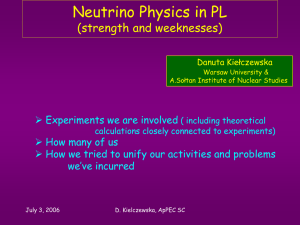Successful Observation of the Oscillatory Pattern of Neutrino Mixing
advertisement
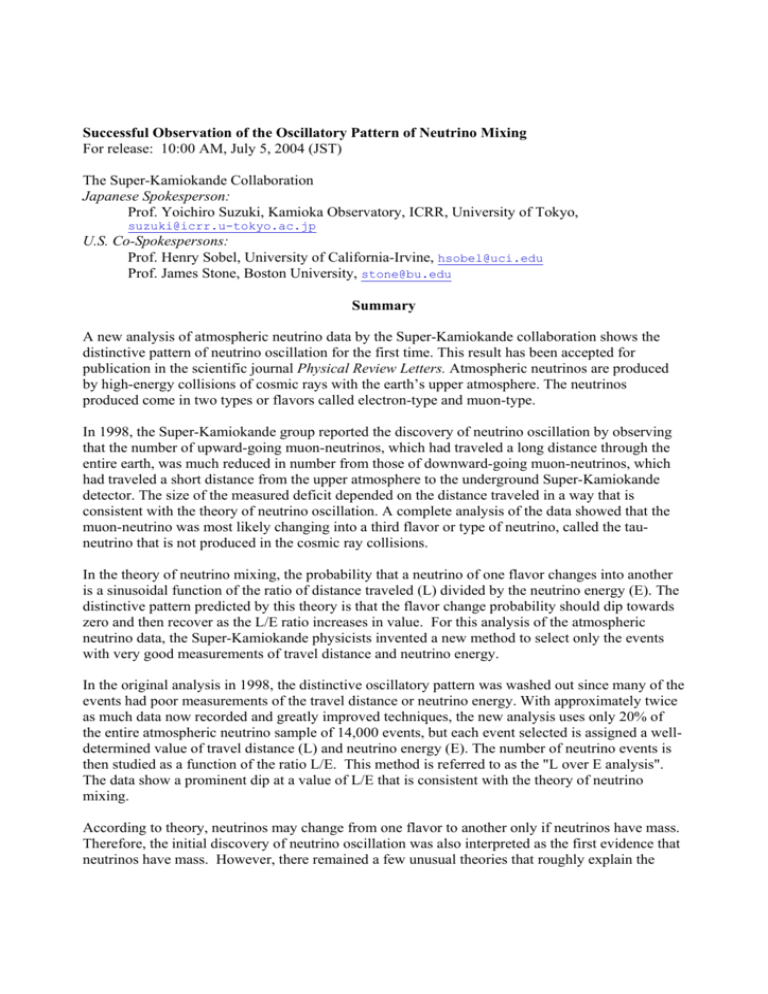
Successful Observation of the Oscillatory Pattern of Neutrino Mixing For release: 10:00 AM, July 5, 2004 (JST) The Super-Kamiokande Collaboration Japanese Spokesperson: Prof. Yoichiro Suzuki, Kamioka Observatory, ICRR, University of Tokyo, suzuki@icrr.u-tokyo.ac.jp U.S. Co-Spokespersons: Prof. Henry Sobel, University of California-Irvine, hsobel@uci.edu Prof. James Stone, Boston University, stone@bu.edu Summary A new analysis of atmospheric neutrino data by the Super-Kamiokande collaboration shows the distinctive pattern of neutrino oscillation for the first time. This result has been accepted for publication in the scientific journal Physical Review Letters. Atmospheric neutrinos are produced by high-energy collisions of cosmic rays with the earth’s upper atmosphere. The neutrinos produced come in two types or flavors called electron-type and muon-type. In 1998, the Super-Kamiokande group reported the discovery of neutrino oscillation by observing that the number of upward-going muon-neutrinos, which had traveled a long distance through the entire earth, was much reduced in number from those of downward-going muon-neutrinos, which had traveled a short distance from the upper atmosphere to the underground Super-Kamiokande detector. The size of the measured deficit depended on the distance traveled in a way that is consistent with the theory of neutrino oscillation. A complete analysis of the data showed that the muon-neutrino was most likely changing into a third flavor or type of neutrino, called the tauneutrino that is not produced in the cosmic ray collisions. In the theory of neutrino mixing, the probability that a neutrino of one flavor changes into another is a sinusoidal function of the ratio of distance traveled (L) divided by the neutrino energy (E). The distinctive pattern predicted by this theory is that the flavor change probability should dip towards zero and then recover as the L/E ratio increases in value. For this analysis of the atmospheric neutrino data, the Super-Kamiokande physicists invented a new method to select only the events with very good measurements of travel distance and neutrino energy. In the original analysis in 1998, the distinctive oscillatory pattern was washed out since many of the events had poor measurements of the travel distance or neutrino energy. With approximately twice as much data now recorded and greatly improved techniques, the new analysis uses only 20% of the entire atmospheric neutrino sample of 14,000 events, but each event selected is assigned a welldetermined value of travel distance (L) and neutrino energy (E). The number of neutrino events is then studied as a function of the ratio L/E. This method is referred to as the "L over E analysis". The data show a prominent dip at a value of L/E that is consistent with the theory of neutrino mixing. According to theory, neutrinos may change from one flavor to another only if neutrinos have mass. Therefore, the initial discovery of neutrino oscillation was also interpreted as the first evidence that neutrinos have mass. However, there remained a few unusual theories that roughly explain the deficit of upward-going muon neutrinos, such as the case where neutrinos decay to other particles. This new analysis by Super-Kamiokande rejects those theories, since they do not predict the oscillatory pattern. Also, the location of the dip in the oscillatory pattern is a measurement of the mass difference between the neutrinos. The new measurement by Super-Kamiokande represents the most precise measurement of the mass difference to date. It is the goal of upcoming accelerator based experiments to make even more precise measurements. The Super-Kamiokande Collaboration includes scientists from institutions in Japan, the United States, and Korea. Principle funding for the experiment is provided by the Japanese Ministry of Education, Science, Sports, and Culture, the United States Department of Energy and National Science Foundation. In addition to advancing our understanding of basic science, the collaboration has established a strong international partnership between the Japanese and American teams. For more information, please visit: http://www-sk.icrr.u-tokyo.ac.jp/doc/sk/index.html The Super-Kamiokande Collaboration: Kamioka Observatory, Institute for Cosmic Ray Research, University of Tokyo Research Center for Cosmic Neutrinos, Institute for Cosmic Ray Research, University of Tokyo Department of Physics, Boston University, Boston Physics Department, Brookhaven National Laboratory Department of Physics and Astronomy, University of California, Irvine Department of Physics, California State University, Dominguez Hills Department of Physics, Chonnam National University Department of Physics, George Mason University Department of Physics, Gifu University Department of Physics and Astronomy, University of Hawaii Department of Physics, Indiana University Institute of Particle and Nuclear Studies, High Energy Accelerator Research Organization (KEK) Department of Physics, Kobe University Department of Physics, Kyoto University Physics Division, P-23, Los Alamos National Laboratory Department of Physics and Astronomy, Louisiana State University Department of Physics, University of Maryland Department of Physics, Massachusetts Institute of Technology Department of Physics, University of Minnesota, Duluth Department of Physics, Miyagi University of Education Department of Physics and Astronomy, State University of New York, Stony Brook Department of Physics, Nagoya University Department of Physics, Niigata University Department of Physics, Osaka University Department of Physics, Seoul National University International and Cultural Studies, Shizuoka Seika College Department of Systems Engineering, Shizuoka University Department of Physics, Sungkyunkwan University Research Center for Neutrino Science, Tohoku University The University of Tokyo Department of Physics, Tokai University Department of Physics, Tokyo Institute for Technology Institute of Experimental Physics, Warsaw University Department of Physics, University of Washington
